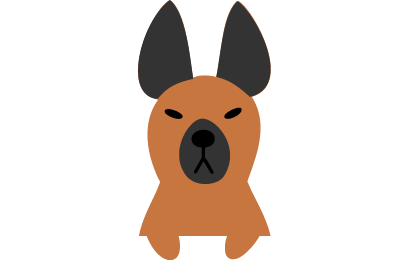Veterinary Education
Practical Training in Small Animal Internal Medicine
Practical training in internal medicine encompasses much more than just learning about non-surgical treatments (medications). In this training, our students must grasp the medical issues faced by an animal patient actually being admitted to our hospital, and formulate approaches and treatment plans for the differential diagnoses under consideration. Specifically, students must focus on investigating their cases in ways that cause no pain to animals, such as interviewing the owner about the history of the animal’s complaint, physical examinations, microscopic examination of blood and tissues, and interpretation of diagnostic images. Students have to pass the relevant exam (the Veterinary Common Achievement Test [VCAT]) following the completion of required amount of education, and only students who satisfy these conditions are allowed to handle animals that come to our hospital. The ultimate purpose of this practical training involves instilling the students with “Day One Skills” (the standard medical skills to do the job), but it is not limited to that. By taking on the medical care of animals, students can master an adequate level of communication skills. They are put in situations where they must address problem solving in a clinical setting, asking themselves what is needed to successfully resolve the cases of a wider range of animal patients.
Hands-on Training in Small Animal Surgery
Fifth- and sixth-year students of the Joint Faculty of Veterinary Medicine are required to participate in clinical clerkships in veterinary surgery at the KUVTH for approximately one month. The crucial aspect of clinical clerkships is that students do more than observe; they are actively engaged in caring for and handling animal patients.
Specifically, students:
- interview the owner to establish the patient’s symptoms and the history of the complaint,
- perform a general physical examination working with the veterinarian-in-charge and a battery of other examinations such as blood tests and X-rays as needed,
- assist the surgeon or anesthesiologist during surgery,
- disinfect the surgical area before the surgery and provide post-operative care and treatment.
In this way, students put the knowledge gained in the classroom to practical use.
Needless to say, all practical training is conducted under close supervision of faculty veterinarians to ensure the safety of patients. One of the primary missions of the Kagoshima University’s Veterinary Teaching Hospital is teaching, as its name implies, and KUVTH is a designated secondary care hospital that accepts the patients referred by their primary care veterinarian for specialized care. Cooperation and support from animal owners and practitioners in our community enable our DVM students, the veterinarians of tomorrow, to gain fundamental competencies and skills requisite to their success. We appreciate your understanding, support and cooperation.
Practical Training in Emergency & Critical Care (after hours: 7 pm - 6 am)
KUVTH offers emergency services after hours from 7 pm until 6 am on weekdays to provide critical veterinary care to dogs and cats who suddenly become unwell at night. The cases in emergency and critical care services are diverse, ranging from epileptic seizures, vomiting, and foreign body ingestion to urinary retention and trauma. We have clinical clerkships in Emergency & Critical Care for our fifth- and sixth-year students, with students joining the after-hours emergency care team singly or in pairs, for one week at a time. Under the supervision of the faculty veterinarian-in-charge, they perform medical interviews and examinations to acquire the essential competencies and skills they will need to deal with emergencies after they become qualified veterinarians.
Practical Equine Medical Training
Our faculty’s specialist veterinarians in the Equine Medical Center educate our fifth- and sixth-year students about equine veterinary medicine including:
- how to approach a horse safely;
- how to best care for horses;
- how to fix the position of horses in various situations;
- how to take X-rays;
- how to diagnose and provide appropriate treatment;
and techniques for various injections in a clinical setting.
Horses can be intimidating to the uninitiated because of their size, but most horses we examine and treat on a daily basis are well trained and obedient. So long as certain rules are followed, the majority of horses are not dangerous. However, caution is always required when treating horses however docile they seem to be. Our students are of course trained on the principles of equine veterinary medicine, but they also learn the rules of horse handling, and how to safeguard their own security, as well as that of the horse and other people in its vicinity. Because the horse population is small relative to those of other animals, the number of veterinarians involved in equine veterinary medicine is smaller than those in other fields. However, horses are bred and kept in all parts of Japan. We are committed to offering advanced veterinary medical care in compliance with the highest standards using state-of-the-art diagnostic equipment and outstanding expertise for our equine patients.
Hands-on Training in Bovine Medical Practice
Our faculty’s specialist veterinarians in the Bovine Medical Service educate our fifth- and sixth-year students about bovine veterinary medicine. The education encompasses a wide variety of diagnostic and therapeutic techniques, as well as cattle husbandry. There are many cattle farmers in Kagoshima Prefecture, largely concerned with beef or dairy production. These cattle represent the farmers’ prize assets, and we provide support in the form of both therapy and prevention. Cattle are herbivores and generally calm, but a lack of knowledge on their physiological ecology can results in serious injury when approaching these large animals. With livestock, veterinary care is also geared to improve yields. Naturally we teach our students the principles of bovine medicine, but they are also educated on safe cattle-handling techniques, rearing and feeding management, skills for client communication with farmers through their training in actual clinical settings. Furthermore, we collaborate with field veterinarians of National Agricultural Insurance Association (NOSAI) in Kagoshima Prefecture at the Osumi Large Animal Clinical Center, to provide our students with opportunities for actual clinical practice with cows in field settings.


